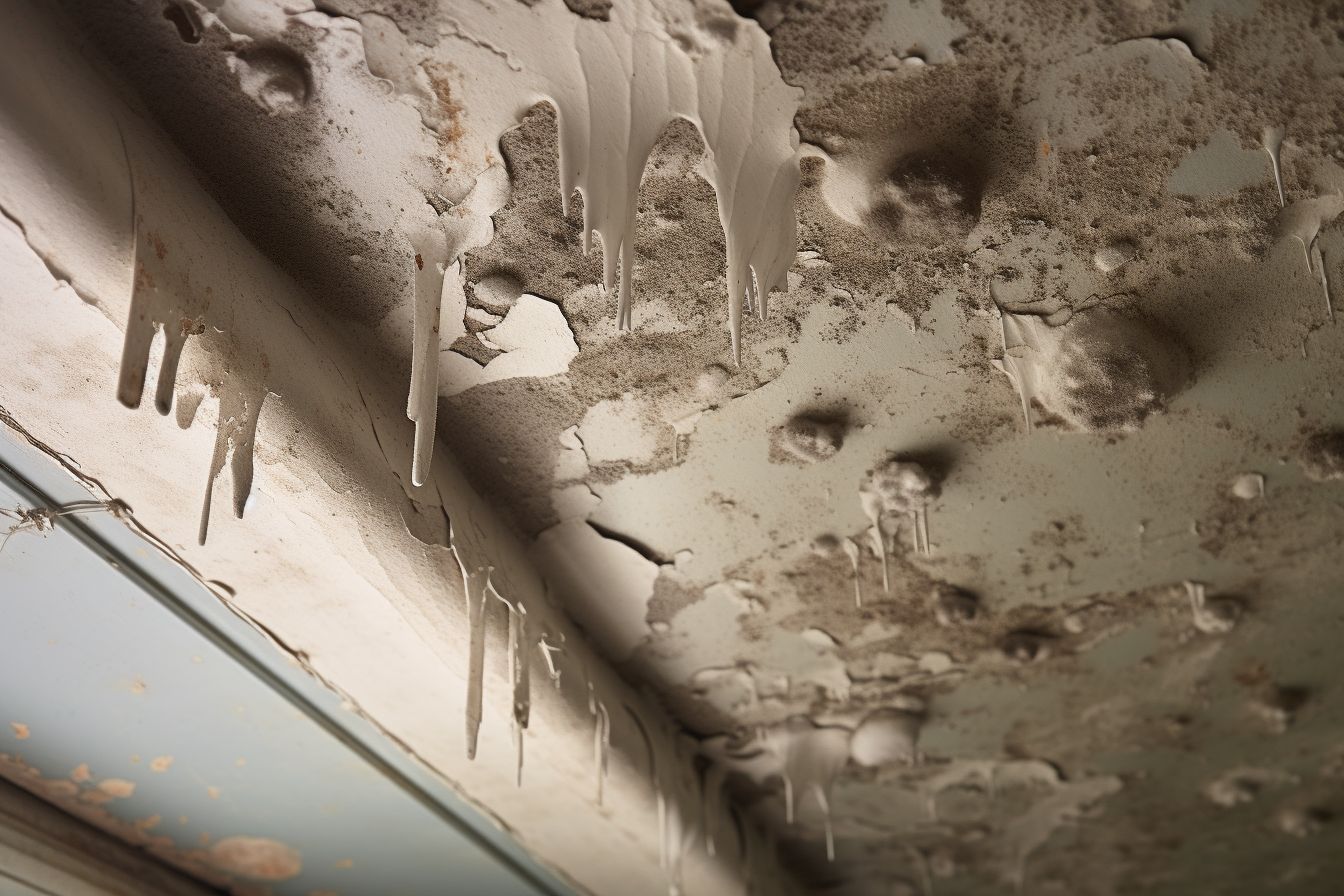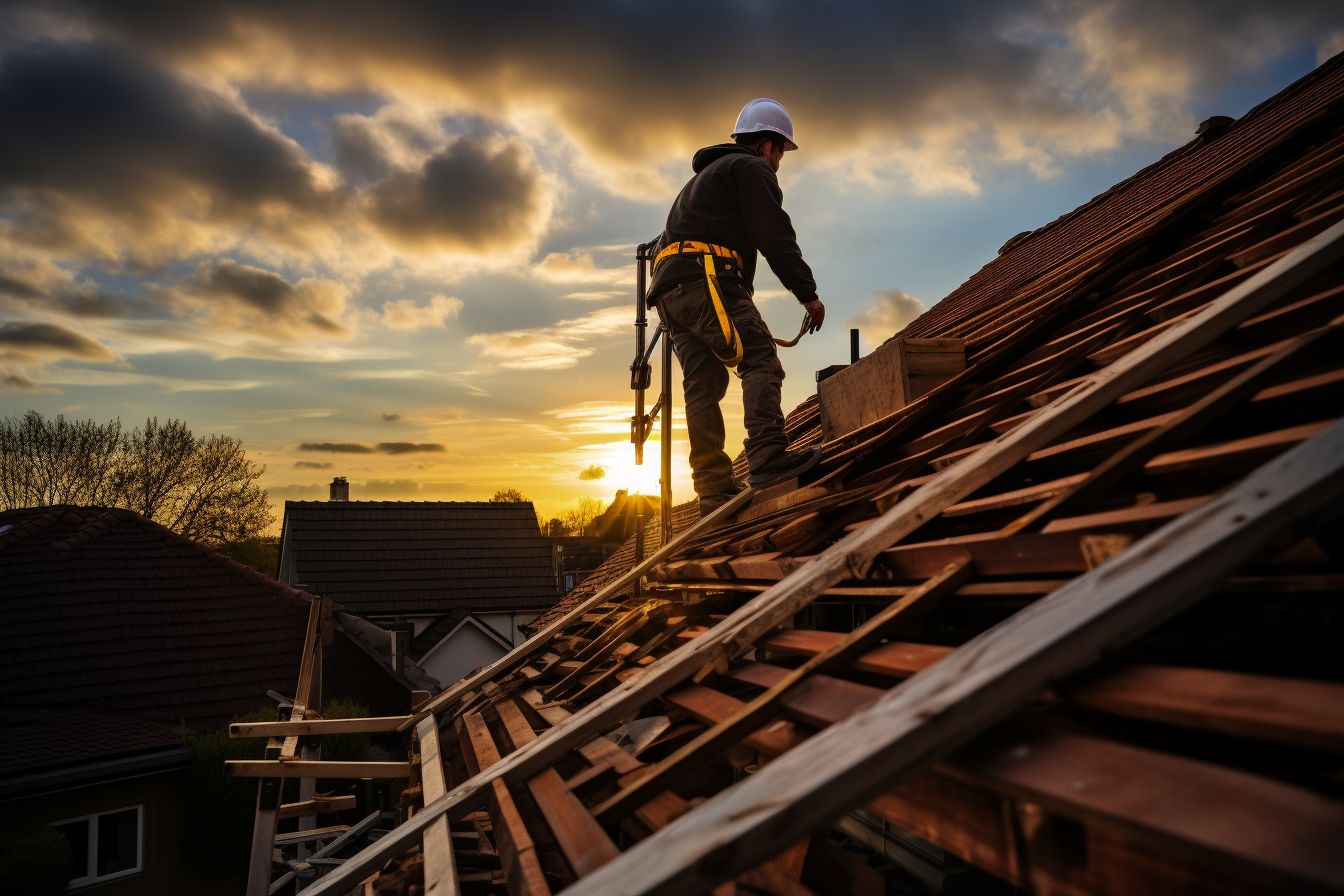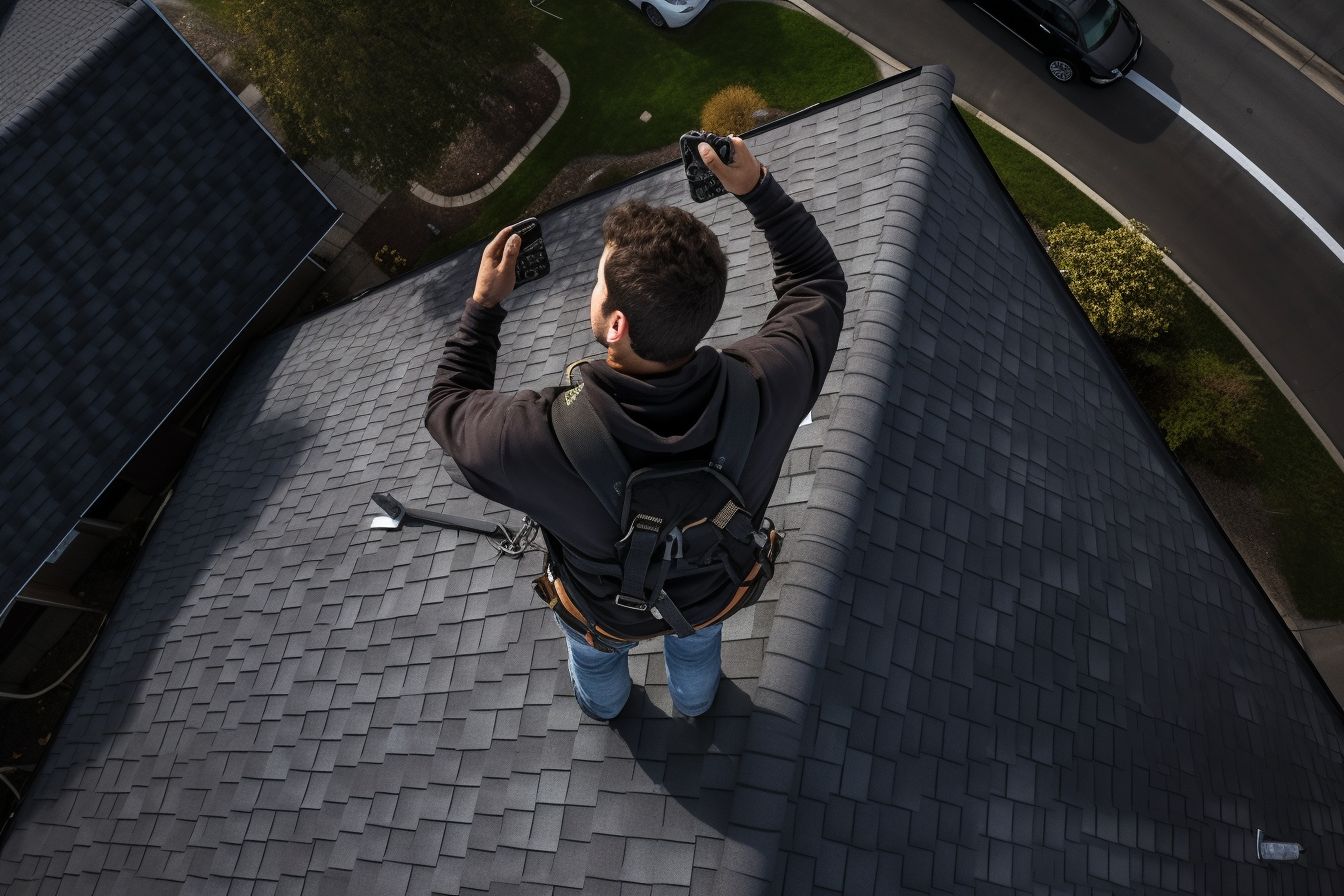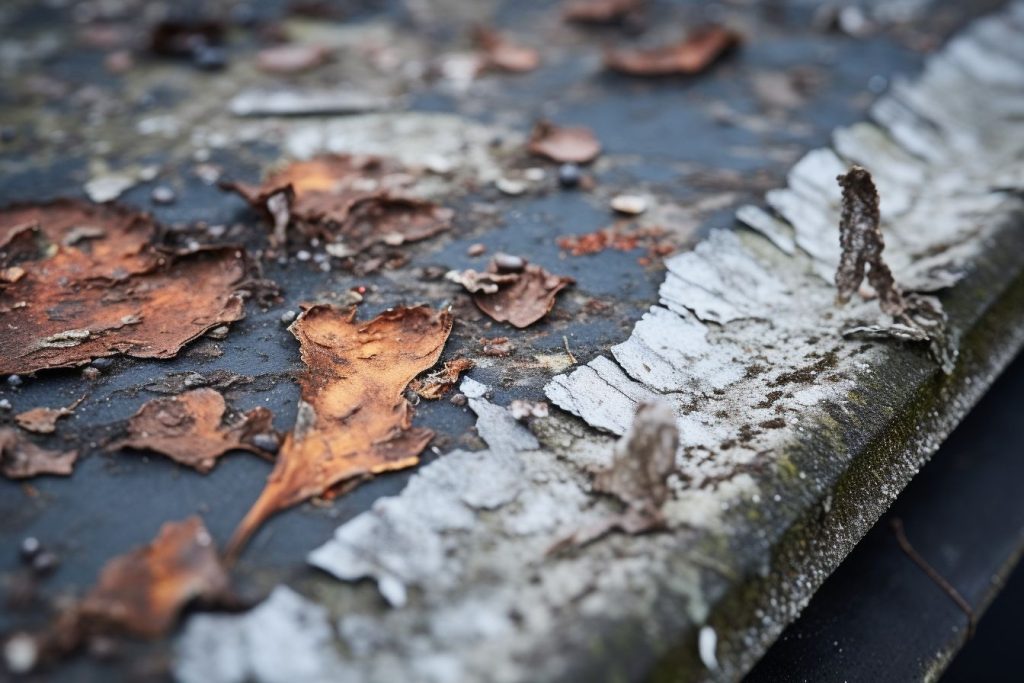Experiencing a roof leak can be a stressful event, especially when it leads to mold growth. In fact, did you know that mold can occur just within days of a leak? This blog will guide you through understanding how leaks lead to mold and steps to take in addressing this issue.
Let’s dive in and make your home safe again!
Key Takeaways
- Roof leaks can lead to mold growth in homes, causing risks and health hazards if left unaddressed.
- Taking swift action to repair roof leaks is essential for maintaining a healthy and safe home environment.
- Fixing the roof leak immediately prevents further water damage and halts the growth of mold.
Understanding the Connection: How Roof Leaks Cause Mold

Roof leaks can lead to mold growth in homes, posing numerous risks and health hazards if left unaddressed.
The process of mold growth after a roof leak
A leaky roof is often the beginning of a mould problem. Dripping water may appear harmless initially, but it creates an ideal environment for mould growth. Water seeping through a damaged roof collects and humidifies the attic and walls, providing ample moisture for moulds to thrive on.
This systemic growth triggers when conditions are perfect – dampness, warmth, and a suitable feeding source such as wet wood or drywall. If unattended over time, the continuous wetting allows mould colonies to prosper considerably and potentially damage critical structural elements of your home.
Mould not only deteriorates interior aesthetics by causing stains but also weakens floors and walls by feeding on moist materials like wood. Incurring significant costs in damage repair isn’t unusual, with persistent leaks fueling rampant mold expansion.
The risks associated with mold in homes
Mold in homes can pose serious health risks and create an unsafe environment for inhabitants. Growths of these fungi produce allergens, irritants, and potentially harmful substances called mycotoxins.
Exposure to these toxins may result in respiratory symptoms similar to those in asthma patients or cause hypersensitivity reactions.
Prolonged exposure amplifies the danger, leading to a condition known as mould toxicity. This chronic illness arises when mold spores infiltrate various areas of the body, causing widespread inflammation and multiple organ system dysfunctions.
For homeowners who have experienced flooding or extensive water damage, immediate action is crucial as moulds thrive in damp conditions and could rapidly colonise your home if not properly managed.
Importance of addressing roof leaks promptly
Taking swift action to repair roof leaks is essential for maintaining a healthy and safe home environment. If left unchecked, water from these leaks quickly creates an ideal breeding ground for mould and mildew.
This not only jeopardises the indoor air quality but also poses serious health risks to ochouse occupantsFurthermore, ignoring a leaking ceiling can lead to structural damage, ruining walls floors and causing extensive water damage throughout your property.
So, please pay close attention to any signs of roof leakage that protect both the integrity of your home structure and its residents’ well-being by preventing mould growth and related hazards.
Steps to Take When Dealing with Roof Leaks and Mold

Could you fix the roof leak immediately to prevent further water damage and stop the growth of mould, then remove the existing mould using proper techniques or hire professionals for thorough mould remediation?
Fixing the roof leak
To fix a roof leak, it is essential to take prompt action. You can start by placing a tarp on the roof and securing it with fasteners if you cannot do it right away. This will help minimise interior damage caused by water infiltration.
Once you can address the leak, follow repair methods suited for your type of leaking roof. It is also crucial to remember that remediation of the roof leak is typically performed by a roofing contractor rather than a mould remediation contractor.
By taking these steps, you can effectively stop the water from entering your home and prevent further damage.
Removing the existing mould
It is crucial to act promptly to remove existing mould caused by roof leaks. Scrub the mould from hard surfaces using a detergent and water solution. Make sure to dry the area afterwards to prevent further growth thoroughly.
If needed, commercial products or a bleach solution can be used for stubborn mould stains. Please remember that any damp materials should be cleaned and dried within 24-48 hours to reduce the risk of mould spreading.
For extensive mould infestations, hiring professionals specialising in mold remediation is advisable to ensure proper removal and eliminate any potential health hazards associated with mould exposure.
Hiring professionals for mould remediation
Hiring professionals for mould remediation is highly recommended when dealing with roof leaks and mould. These experts have the necessary skills and knowledge to effectively remove mould from your home.
They can assess the extent of the mould growth, identify hidden mould problems, and take appropriate measures to remove it safely. Additionally, hiring professionals ensures that the job is done correctly and thoroughly, reducing the risk of further damage or health issues caused by exposure to mould spores.
The Department of Labor mandates that professionals involved in mould assessments and remediation meet specific training requirements, licenses, and work standards to ensure their qualifications.
Homeowner’s Manual for Handling Roof Leaks

Fixing a roof leak is crucial to prevent further damage and mould growth. Follow these steps to handle roof leaks effectively:
– Inspect the area for any visible signs of water damage, such as stains on the ceiling or dampness on the walls.
– Locate the source of the leak by checking for missing shingles, damaged flashing, or cracked seals around vents and chimneys.
– Make necessary repairs by replacing damaged shingles, sealing gaps in flashing, or applying roofing cement to fix leaks.
– Monitor the repaired area for any recurring leaks or signs of moisture to ensure the repair succeeded.
Just to remind you, prompt action is critical when it comes to addressing roof leaks. Following this homeowner’s manual, you can effectively handle roof leaks and minimise their potential for causing mould growth and further damage.
Prevention and Maintenance Tips to Avoid Roof Leaks and Mold

Regular roof inspections, prompt addressing of any signs of damage or leaks, ensuring proper ventilation and insulation, maintaining gutters and downspouts, and addressing water-related issues in the home, such as humidity and plumbing leaks, are crucial steps to avoid roof leaks and mould.
Regular roof inspections
Regular roof inspections are crucial for preventing roof leaks and mould issues. By conducting routine inspections, homeowners can identify any signs of damage or potential leaks before they become significant problems.
This proactive approach helps to address minor issues early on, saving homeowners from costly repairs in the future. Regular inspections ensure the roof is maintained correctly, extending its lifespan and preventing water damage.
We are taking preventive measures like cleaning gutters and downspouts, checking for proper ventilation and insulation, and addressing any water-related issues in the home to help further prevent roof leaks and mould growth.
Could you address any signs of damage or leaks?
Addressing any signs of damage or leaks on your roof is crucial to prevent further problems, such as water damage and mould growth. You must take immediate action if you notice any discolouration, damp spots, or dripping water in your home.
Ignoring these signs can lead to costly repairs and health issues caused by mould exposure. By promptly addressing the damage or leaks on your roof, you can minimise the risks associated with building dampness and ensure a safe and healthy living environment for you and your family.
Ensure proper ventilation and insulation.
Proper ventilation and insulation are crucial in preventing roof leaks and mould growth. Ensuring your home has adequate airflow can reduce the chances of moisture buildup and mould formation.
Proper insulation also helps regulate surface temperature, preventing condensation that can lead to mould growth. Installing a well-functioning ventilation system and improving insulation effectively control humidity levels and keep your home from mould-related risks.
You can take proactive steps to address any issues with ventilation or insulation to create a healthier living environment for you and your family.
Please be sure to maintain gutters and downspouts.
Regular maintenance and upkeep of gutters and downspouts are crucial in preventing roof leaks and mould growth. Clogged or blocked gutters can lead to water overflow, seeping into the roof and causing damage.
Keeping gutters clean and free from debris, such as leaves or twigs, ensures that water flows freely away from your home instead of pooling near the foundation or leaking into the attic.
Regularly inspecting gutter joints and downspouts for leaks or loose connections is essential to prevent water damage. By addressing gutter issues promptly, you can avoid costly repairs down the line and maintain a healthy and dry living environment.
Address water-related issues in the home (humidity, plumbing leaks, etc.)
To prevent roof leaks and mould growth in your home, it is crucial to address water-related issues promptly. High indoor humidity can contribute to condensation and create an environment for mould to thrive.
Take steps to control humidity levels by using ventilation systems or dehumidifiers. Additionally, be vigilant about plumbing leaks and fix them immediately. Regularly inspect your gutters and downspouts, ensuring they are clear of debris to prevent water backups that could lead to roof damage.
By proactively addressing these water-related issues, you can mitigate the risk of mould growth in your home.
To avoid costly repairs and potential health hazards associated with mould, it’s essential to take preventative measures. Please check for signs of water leaks or moisture buildup around your home’s pipes, faucets, or appliances.
Proper insulation will also help control condensation on cold surfaces like windows or walls. Please maintain proper foundation drainage by landscaping slopes away from the house and regularly cleaning out gutters and downspouts.
Conclusion
In conclusion, quick intervention is crucial regarding roof leaks and mould. Addressing roof leaks promptly and fixing the underlying cause can prevent mould growth and avoid costly damage.
Please remember to hire professionals for mould remediation and take preventive measures to ensure proper roof maintenance to avoid future issues with water damage and indoor mould.
FAQs
1. How can I tell if my roof is leaking?
You can tell if your roof leaks by looking for water stains on the ceiling, dampness in the attic, or visible signs of water dripping or pooling.
2. What should I do if I discover a roof leak?
Suppose you find yourself in a roof leak. In that case, it’s essential to take immediate action by placing a bucket under the leak to collect the water and contacting a professional roofer to take care of the issue.
3. Can a roof leak cause mould growth?
A roof leak can accumulate moisture, creating ideal mould growth conditions. It’s essential to address the leak’s source and mould immediately.
4. How can I prevent mould growth after fixing a roof leak?
To prevent mould growth after fixing a roof leak, ensure proper ventilation in affected areas, remove any damaged materials or insulation that may have been exposed to moisture, and consider using dehumidifiers or fans to keep humidity levels low.
5. Should I attempt DIY repairs for my leaking roof?
Attempting DIY repairs for a leaking roof is not recommended as it requires expertise and specialised tools. Hiring an experienced roofing professional who can safely identify and fix the problem without causing further damage is best.

